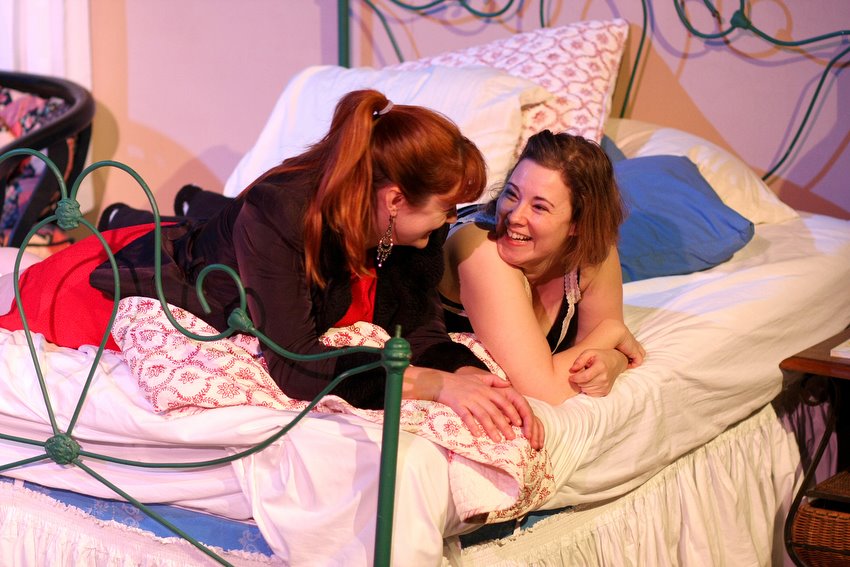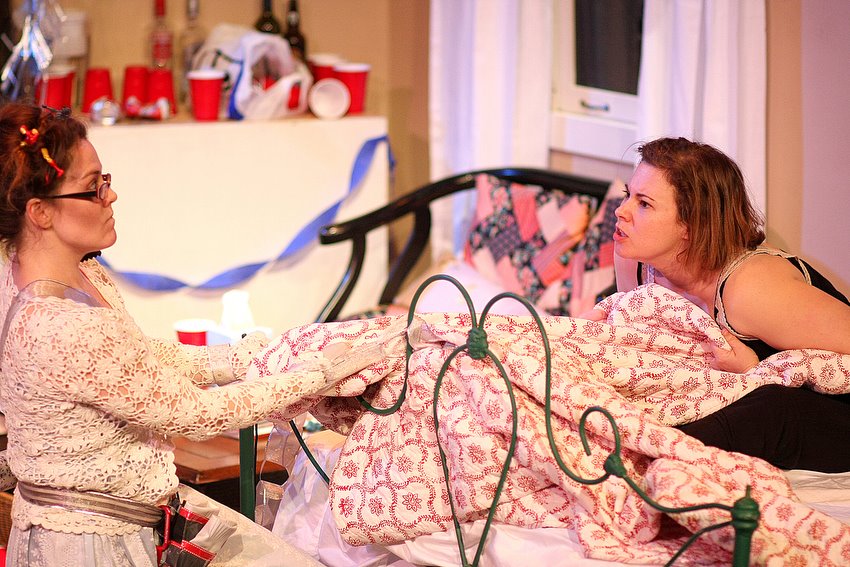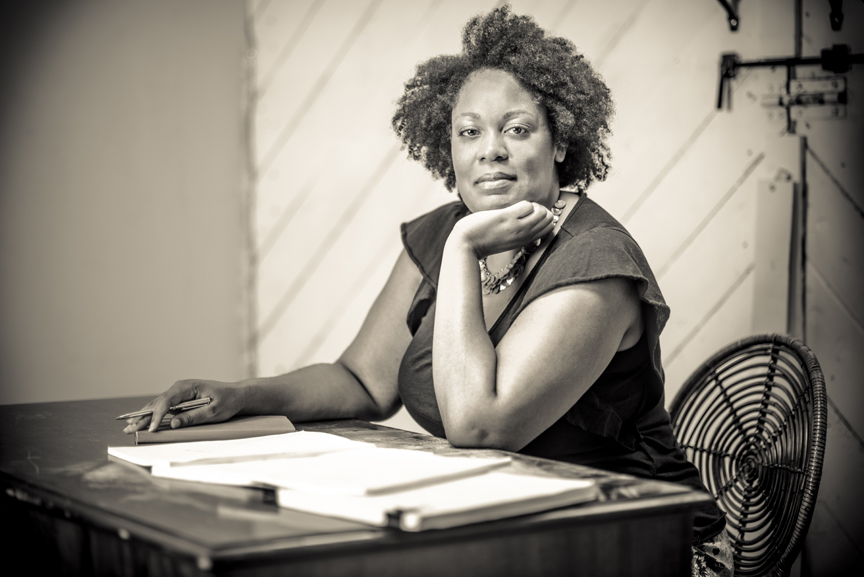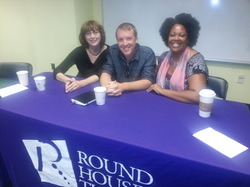 On Tuesday, playwrights Bari Biern, Stephen Spotswood and I took part in a panel discussion on the Life and Work of a Playwright as part of Round House Theatre's Heyday Players' Fall Master Classes. The Heyday Players senior theatre program is dedicated to enriching the lives of senior citizens by channeling their tremendous spirit, talent, and life experience into theatrical performance. The weekly master classes with D.C. area theatre professional helps participants continue to develop their performance skills. The panel was moderated by Jillian Levine-Sisson, Education & Outreach Program Manager, and Brianna Letourneau, Lead Teaching Artist. In August, we were given our theme and we have until December 1st to work on the first draft. This year’s theme is Campfire Stories. I'm so excited! I'm going to write about a Girl Scouts Reunion. Just think of the bitter badge wars and crooked cookie sale rivalries; it's going to be great! We'll get notes from Jillian and Brianna, and do rewrites in December. In January, the Heyday Players begin rehearsals. In May of 2013, the Heyday Players will perform the plays in senior centers, hospitals, and community centers across Montgomery County, and at Round House Theatre's Silver Spring space. Closer to the performance date, I'm going to interview the playwrights and share more about our experience. For now, here are a few words from us about our working with the Heydays and on the panel discussion. 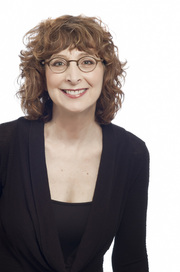 BARI BIERN This is my Fourth year writing for the Heyday Players. My favorite play was the adaptation of "Little Women", although I would have really enjoyed writing a ten-minute version of "Anna Karenina", too! Being in a classroom setting is completely outside my comfort zone. Last year, when I was invited to to teach a two-part Heyday master class in adapting stories for the theatre, I was terrified. The Heydays aren't fresh-faced eager young kids---they're fresh-faced eager mature adults with a lifetime of knowledge and experience. I got a terrific pep talk from Jerry Whiddon and outstanding support from Jillian and Brianna. Once I got past my own insecurities, I was thrilled to see the Heydays immediately use the tools I shared with them to create--and perform--their own stage adaptations of fables. There's a tremendous amount of talent in this group. What excited me about this year's Master Class was the new sense of cohesion between the playwrights and the players. It can't help but inform and enhance the future projects we create together. Thanks to teaching artists Jillian and Brianna for facilitating the discussion with their thoughtful and thought-provoking questions. I was surprised and moved by the discussion of death and other sobering topics as possible themes for Heyday scripts. I tend to lean toward comic pieces, but I'm now open to submitting scripts that have a bit more gravitas or poignance. 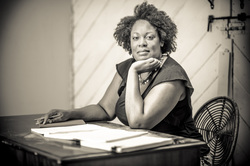 JACQUELINE E. LAWTON This is my fourth year writing for the Heyday Players. It would have been five, but I was busy working on The Hampton Years last year and felt that I couldn't give them the time, focus and energy that they deserved. I regretted not being able to work with them. My favorite play is my 10 minute Merchant of Venice entitled The Beauty Shop Supplier of Montgomery County. It's a riotous story of a town divided between those who go to the salon and those who do their own hair! Schuyler gives a very stirring and moving speech in support of her home perm! The panel discussion really was great! One of the best I've been on in a long time. Jillian and Brianna did an excellent job covering issues that impact theatre artists on a local and national scale, while also addressing our personal experiences and journeys as artists. It was an intimate setting and a lively conversation. The best part was being able to interact with the Heyday Plays. Normally, we only meet with them at the performance in May. I was so surprised and excited by how truly interested they were in the writing process and in our lives as playwrights. 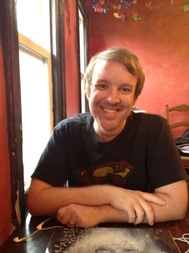 STEPHEN SPOTSWOOD This is my third year writing for the Heyday Players. My favorite play (that I wrote) was THE THIN MAN RETIRES. The prompt that year was Great Works of Literature. I chose Dashiell Hammett's The Thin Man, which I'm a great fan of. I got to explore not only that light-hearted mystery genre Hammett created, but the theme of marriage making the hero a better detective. I'd never gotten an opportunity to interact with the Heyday Player members before participating in the Master Class. It was great to put personalities to the faces and voices I'd seen on stage. How interested they were in the playwriting side of things. They asked very intelligent and incredibly relevant questions. I could put together a college-level study guide out of their questions and comments. It was a really wonderful day. The two hours flew by and we could have easily spent another hour or so in conversation. It was inspiring to hear about from Bari and Stephen about their life journeys, ambitions and careers. It was thrilling to be a part of the Heyday Players master class and to learn more about what interests them. Please enjoy a few photos from our day together.  To learn more about Master Classes and/or to join the Heyday Players troupe, or book a performance at your location, contact the Education Center at 301.585.1225 or [email protected].
0 Comments
TCG's 2012 Young Leader of Color, Andre Lancaster, responds to Drew Barker's question on diversity and inclusion. "How do institutions and artists negotiate between sincere attempts at 'bridge-building' and creating productive 'multicultural' explorations without falling into the potential traps of audience pandering or cliché?" This Burden Called My Queer Black Theatre? 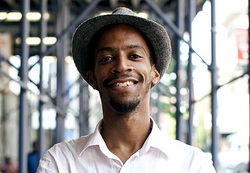 The responses to Drew Baker's diversity and inclusion question that TCG Young Leader of Color Jacqueline Lawton has gathered so far could not be any more thoughtful or compelling. In light of the strength of these responses, I am going to take a bit of a different direction in my response and attempt to lay down a foundation so to speak underneath the ideas put forth so far. The foundation essentially being a call for an industry wide recognition and valuing of the privileges as well as the burdens with which leaders of the diversity and inclusion movement carry. The nation's largest black theater, Penumbra Theatre in Minneapolis, in difficult financial straits. Latinos at odds with TheaterWorks' color blind production of Stephen Adly Guirgis’ unequivocally color conscious play The Motherfucker With the Hat. Asian American Performers Action Coalition armed with empirical data and in full Saul Alinsky organizing mode in efforts to compel centers of influence – on and off Broadway -- to listen and to change. It would seem these days that to be of, for, and by identity theater, brings with it a host of burdens that our white, heterosexual, economically privileged and all of the above peers just don't have to be bothered with. In the circles that I travel in, I could make what I like to call the "separate and burdened" case 'til the cows come home without one peep of disagreement. Colleagues and friends around the cafe table and on my Facebook page would certainly nod and like -- as any reasonable citizen of our industry might. But it is in reflecting back on amen corner scenes like these that I ask: are we more than the sum of our burdens? Recently Leviathan Lab, an emergent NYC based Asian American theater company preparing to enter into season selection processes, invited me to come in and consult with them about season selection models out there in the field. It was quite a learning experience for me to work with them and I am so thankful for organizations like Leviathan Lab – led by stage director Nelson Eusebio -- that give actors opportunities to put their dramaturgical hats on. (Talk about underused national resource people!) In the middle of that conversation, the following question sparked further meaningful inquiry: What is an identity specific theater's responsibility to produce work created and written by said identity? Though the debates around representation at Freedom Train, an identity focused theater I founded in 2006 to expose audiences to black queer stories and theater makers, involve different specifics the questions at Leviathan Lab were not dissimilar to the ones with which Freedom Train regularly wrestles: If we are not advocates for voices from our community then who will be? How far actually are we taking this identity thing anyway? Must the playwright, stage manager and wide eyed intern all be, to borrow a culturally specific term, "family"? Does black come before queer or does queer come before black!? I mean seriously folks, no stone is left unturned. This summer at Theatre Communications Groups' national conference in Boston, TCG Young Leader of Color Alfred Heartley, a brilliant Chicago based producer and dramaturg fresh off an artistic fellowship at Steppenwolf, shared this in one of the conference’s final breakout sessions, "Change is not necessarily for you, it is for the people who come after you." You just gotta love you some Al who in true dramaturg form succinctly reflected back the opinion nascent in the room. My take away from what Al said was that, yes, we've got problems to face up to and discrepancies to tackle that exist between our field's values and its actions. Yes, we must simultaneously participate in that work (often times by leading them) as we also make work with peers and hopefully add something new to the form and something different to the discourse. But is it just a burden though? Can our position also be seen as a… privilege? Personally whenever I see old footage of African American director Lloyd Richards reflecting back on the A Raisin in the Sun try out tour or when history comes for a visit and shows off the past heroism of her brave children of the 1960s, I lean in. I get jealous in that I wish I could have been there kind of way. You know… fighting the fight, modeling the movement, and teaching through theater. But that was then; what about the role we can play today? I certainly don't think I have all the answers folks, and honestly some days the burdens are too much to bear and I feel as if I could easily chose a title which would not include a question mark. Coming up for me is a speaking gig at Pratt University put on by Live Out Loud whose mission is to inspire and empower LGBT youth by connecting them with successful LGBT professionals in their community. I and several others will speak before an audience of college students about our experiences coming out and how we negotiate coming out with our careers. It goes unsaid but really needs to be said: to be young queer and living in these times is still a mark -- no matter how hard the neo-con gay marriage movement tries to put an acceptably nice middle class sheen on the gays. These kids at Pratt know better. I am beginning to outline my remarks and one question that's been front in center so far is one that is also front and center in this post: How do I share the privileges of being an out queer African American theater producer without seeming tone deaf to the realities that exist? Woolly Mammoth Theatre Company's Director of Marketing and Public Relations, Deeksha Daur, responds to Drew Barker's question on diversity and inclusion. "How do institutions and artists negotiate between sincere attempts at 'bridge-building' and creating productive 'multicultural' explorations without falling into the potential traps of audience pandering or cliché?" Priorities, Values, and Responsibility 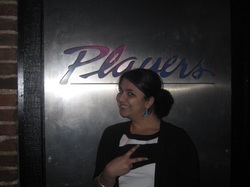 As a student in grad school, and then again as a TCG New Generations mentee, I had the privilege of doing a workshop with Ben Cameron of the Doris Duke Charitable Foundation. Ben gave us a worksheet with, say, 15 values on it (work, travel, adventure, freedom, family, religion, etc). We were supposed to number them in order of importance: 1 as the most valuable; and 15 as the least. We put our lists in an envelope and handed it back to him. At the end of the class, he gave us a new work sheet with the same 15 items on them. This time, we had to number them in order of how we actually functioned in our daily lives. It was unbelievable! Some people might say that their number one priority was family, but they worked 17 hours a day and saw their families once a year. The dissonance really shook us out of our skins! Years later, this values exercise is constantly on my mind. What do we say are our values? And do our actions prove or disprove them? I believe that these questions are at the heart of how to negotiate the line between sincere “bridge-building” versus audience pandering and cliché. What are your values? What are the things you’re not willing to compromise? And how much are you willing to sacrifice to achieve them? I think every institution should go through this exercise, and identify three real values without which the organization would cease to exist as it is. (I don’t believe sustainability or balanced budgets should be included—those are tools or outcomes, not values. But that’s just me.) So, at Woolly Mammoth, my current employer, those values might be shaking people out of their comfort zone, or furthering the art form by producing new American plays, or creating deep engagement and discourse in DC, through the active recruitment of new perspectives and non-theatergoing audiences. If diversity is a priority or a value—make it a priority. Don’t just do a play. Program your season to reflect a multiplicity of voices. Convince people that your season reflects a plethora of different people—not just one ethnicity, or gender, or age group. Recruit boards and staff of color—and even more importantly, people who are committed to furthering a diversity agenda. Go into your community and talk to potential stakeholders. Reflect issues that are relevant to them. Reflect the times. Change the model. I am inspired by the Esplanade—Theatres on the Bay, in Singapore. A giant national performing arts center, their mission is to provide the arts to EVERYBODY. I remember seeing that mission statement emblazoned across their offices and smirking—in the way that naïve and overly-confident grad students are wont to do—at the fact that they were breaking the first rule of mission statements, the rule that you cannot be for everybody. But the Esplanade, well, walks the walk. Under the CEO are pods of dual-headed teams: an artistic leader, and a marketing leader. The artistic head curates theatre, movies, music, and fine art that reflects a multiplicity of different backgrounds, cultures, generations, and ethnicities, and the marketing head, well, markets it. But the marketing department also identifies Singaporean communities that are not being represented and brings them to artistic’s attention. They are not dictating what work to curate, simply that there is a community whose voice is not being heard. They work together to fulfill a community-centric mission statement. Clearly, achieving genuine bridge-building is not easy. But if our president and first lady are to be believed, change is hard. And it takes commitment. That is the ONLY way to be sincere. So, decide your priorities and work at them. If you’re not going to make diversity one of your top three values, you’re not going to further this particular conversation. Anything else may be perceived as pandering, so your time is better spent on that which you really do value. But ignore diversity at your peril: if you don’t make it a priority, you might find yourself sliding into irrelevance much more quickly than you think. TCG's Director of Communication and Conferences, Dafina McMillan, responds to Drew Barker's question on diversity and inclusion. "How do institutions and artists negotiate between sincere attempts at 'bridge-building' and creating productive 'multicultural' explorations without falling into the potential traps of audience pandering or cliché?" Ambassadors for Change 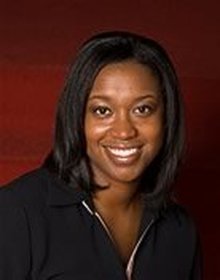 I think cliché and audience pandering happen when we’re not genuine in our motives – and not willing to relate to one another and really connect with each other’s experiences. Sincerity comes when we take a moment (or several moments) to do some introspective thinking about our own biases, assumptions, stereotypes and viewpoints. That’s usually the hard stuff, but it’s so necessary. Every single one us comes into a room with biases, whether we like to admit them or not. I think genuine change happens when we recognize our biases, can be honest about them – and are still willing to be open to others and their differences. One has to be willing to be uncomfortable and that’s something most of us are uncomfortable with doing. Only then can you be genuine and be open-minded to others. It’s an intentional, ongoing process. The practice of being inclusive is an action, a verb. Diversity is what we all bring to the table – quite simply the differences we all have. That difference is what makes it exciting… it’s what makes a brainstorm sizzle with various perspectives, what makes a season of programming more robust and illuminating, and what makes our audiences energized and charged up. So how do we deliberately harness and seek out differences? And how do we create a safe place for those differences to be welcomed and nurtured? As Suzanne Wilkins said at our National Conference, it becomes a question of maturity; it’s the capacity to tolerate complexity and paradox. How do we make space for the experiences of all people? When we address that question, that’s when we make change and lead the charge. Regardless of being an artist or institution – at TCG, we believe we’re all theatre people. Diversity is a core value of TCG and is a key focus in our newly developed strategic plan. I hope we can explore some of these topics at our Fall Forum on Governance: Leading the Charge in November. What does it take to lead the charge with regard do diversity and inclusion? How can we be knowledgeable, equipped with tools and be ambassadors for change? We’ll explore the many intersections of difference, including age, gender, race, class, culture and ability at our Fall Forum. I’m hoping we can move from discussion to action – and overcome the fatigue that has become inherent when diversity is mentioned. I hope as a field we can re-energize the conversation together. -- Dafina McMillan TCG's 2010 New Generations Future Leader, Erica Nagel, responds to Drew Barker's question on diversity and inclusion. "How do institutions and artists negotiate between sincere attempts at 'bridge-building' and creating productive 'multicultural' explorations without falling into the potential traps of audience pandering or cliché?" Make Room, Make Way: Diversity Onstage and Behind-the-Scenes 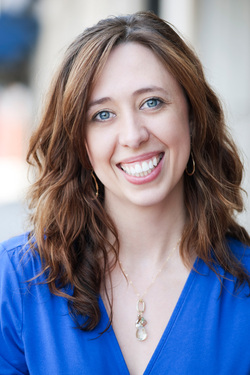 _This question will take a career to answer, but here are my top three thoughts at the moment. 1. Diversify the decision makers. How does a theatre bring in diverse* audiences? Do work by diverse artists. How does a theatre consistently find/commit to/produce work by diverse artists? Hire diverse people in leadership positions where they hold the power to make decisions about what plays are developed and produced. This not only applies to artistic and literary staff positions, but also any position that serves as a gatekeeper to the work pursued by the organization: script readers (including interns), board members, prize committees, casting directors, and grant panels. Theatres that want to create meaningful, long-term relationships with specific demographic communities should have people in positions of real artistic power on staff that share those demographics. Now, I’m not suggesting that people (of all demographic descriptors) are only capable of championing work by people who share those descriptors – that would be ridiculous – but I do believe that our cultural experience, gender, age, heritage and so on is part of what shapes each of our interests, aesthetics, and storytelling vocabularies. And that matters when it comes to choosing the work that is produced on our stages. *Choose your favorite descriptor to stand in where I’ve used the word diverse, and I think it still holds true: young, black, bilingual, middle-aged, white, middle-eastern, economically disadvantaged, local, etc. 2. Sometimes you have to move over to make room. I guess this one is primarily directed at my fellow white people (whether they identify as artists or as administrators in institutions) but it can be applied to folks with any kind of privilege – male, straight, US-born, able-bodied, older/established in the field, etc. Sometimes, it’s possible to add projects or programs to your season that feature artists and themes from a cultural context different than your own without letting go of any other projects or programs. And that’s great. But more often, in a world of limited and often shrinking resources, something’s got to give. And if you really care about “productive multicultural explorations,” they can’t be the last thing added and the first thing cut. Sometimes, the exciting new play by a Latina writer about her family’s South American heritage will have to replace the Arthur Miller revival. Institutions have to make way for this work, not graft it on to an otherwise homogenous season And sometimes (oh boy, here goes...) the exciting new play by an emerging Latina writer will have to replace the exciting new play by an emerging white writer. No one can argue that being a playwright in this country is a privileged position, but systemic suppression of voices of color, women’s voices, queer people’s voices is real and pervasive. And white/straight/able-bodied/etc. artists who care that the theatrical landscape is populated by a multiplicity of voices and cultural experiences have to be okay with the fact that sometimes their work will have to move over to make room. 3. Never shut up about it. Talking about race, access, and privilege is uncomfortable. Sometimes it’s downright scary. Sometimes, you might feel like you’re always the one bringing up questions of diversity in hiring or casting or season planning. Sometimes, your friends might tell you you’re over-reacting to the gender politics of the movie you’ve just seen, or the racist undertones of political news coverage. Sometimes you might feel like maybe you should just not write that blog post because it’s safer to be silent than to potentially say the wrong thing. Sometimes, you feel like the world is telling you to just shut up about it. But we can’t. The only way to move the conversation forward is to keep having the conversation. It’s for people to proudly and publicly identify as advocates for themselves and allies for others. It’s for blogs like this one to offer a safe and stimulating space for those of us that care about issues of power and privilege to hash out what we think and why we think it. Even if we don’t have the solutions to these questions right now, we have to keep pressing ourselves to articulate why the conversation matters. We have to speak up, even (and maybe especially) when the world is telling us to shut up. TCG's 2011 Young Leader of Color, Fanny Garcia, responds to Drew Barker's question on diversity and inclusion. "How do institutions and artists negotiate between sincere attempts at 'bridge-building' and creating productive 'multicultural' explorations without falling into the potential traps of audience pandering or cliché?" Breaking it Down: Open Up, Reach Out, and Listen 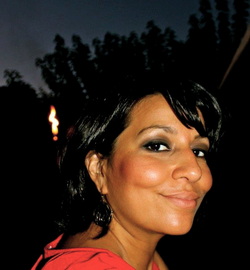 Multiculturalism and bridge-building can’t be done by following instructions in a manual. You have to get your hands dirty. You actually have to do some work. The very words bridge and building specify the strenuous effort it takes to get it right. Bridges must be structurally sound. You can’t build a weak one. If you do, you risk the death of many. Bridge-building in the arts connects people, ideas and cultures. If executed poorly, you risk killing diversity and creativity. Let’s take the term “bridge-building.” Where is this bridge leading? What distance will it span? Is it connecting a city, community or one ethnic group? Which one of the many ethnic groups in your city are you trying to reach? What kind of bridge are you trying to build? Artistic? Academic? Educational? What materials will you need? What aspect of the community are you trying to address? Poverty? Racism? Marginalization? Success? Achievements? History? Who can you bring in to address each individual topic? What is the amount of funding you will need to make this bridge sturdy? Will it stand the test of time or is it a temporary connection? Once you have decided on the type of bridge, then you find someone to build it. Bridge building requires expertise. Who better than to hire someone from the community or ethnic group you are trying to connect with? How about someone who has experienced the complexities of navigating a world as a person of color? What is your hiring process? Is it an organic interview that covers questions about individual convictions or do you focus solely on whether they know how to create budgets? What questions are you not asking that you should be? Now let’s look at multiculturalism. The dictionary defines it as constituting several ethnic or cultural groups within a society. Multi is for multiple, having many different parts and elements. Complex. Each culture with its own set of customs and contributions, each group with its own unique aesthetic, history and legacy. Multiculturalism requires specific knowledge about the demographic population you are trying to reach. It requires that you acknowledge the different ideologies and mores of a community. It requires that you do your homework and research and engage. After seeing all the work that bridge-building and multiculturalism requires, why would you have just one person at your institution to handle them? Why only one show a season about one ethnic group when there are so many in your city? Why would you want to hand this job to someone who is attempting to build a bridge and create diversity from reading a manual? It’s a tough job but someone has to do it. Hire artists of color who want to do it. TCG's 2009 Young Leader of Color, Khanisha Foster, responds to Drew Barker's question on diversity and inclusion. "How do institutions and artists negotiate between sincere attempts at 'bridge-building' and creating productive 'multicultural' explorations without falling into the potential traps of audience pandering or cliché?" Negotiations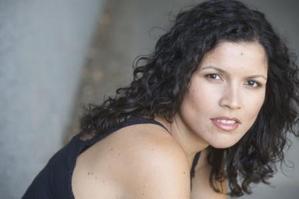 "You are writing for an audience that has not yet arrived . . . In art we put our hands out to the future with no promise that the future will ever put its hand back. All we have is the love of the form and the hope, knowing that we have done the same when we read, that we have read, and by reading a book we have put our hands back into the past, or into another country, or another culture, or another place where we have never been." ~~Junot Diaz In 2009 it was my very first TCG conference. The days leading up to it I’d been a part of a workshop series developed specifically for Young Leaders of Color. We left each session buried deep in conversation. A group of varied tones in both skin and voice, we hurried down stormy streets. At each event we’d arrive soaked and hoarse voiced from the excitement of finding both like-minded and exacting peers. For every agreement there were two doubly fierce challenges. Being one of the new voices in this two year-old program I was giddy at the thought of having these conversations with the national theatre community in the coming days. Now I don't consider myself naive to race. My father was a Black Panther and mother a white suburbanite whose grandfather brought Piggly Wiggly to the Midwest. I was raised by the merging of cultural groups. I was surprised, however, by the repetitive statement I heard cross from room to room. In spaces filled with our nations theatrical leaders I heard the same question: “I don’t understand, we do the Black play, and then the black audiences don’t stay. What are we suppose to do?” What stands out to you about this comment? Answer for yourself before reading ahead, because your reaction to it matters in our conversation. Don’t rush yourself. Get real honest here. Do you agree with it? Can you understand the perspective? Are there words you would change to better fit your opinion? Maybe the concept is familiar? Does it put you off? Does it send you running for a soapbox? Does it make you mad? Okay. Ready for my reaction? First of all, “The Black play…”? This creates an automatic and unnecessary separation between you and an audience you say you are interested in cultivating. If you believe you are doing a group a favor by producing work that represents its voice then you are claiming superiority. We all gain from the shared experience of theatre, whether it is the exact story of our lives of one that took place across the world from us. Theatre is a window to understanding. Doing a play outside of your cultural norm benefits you. It is not a favor. Secondly, why would an audience stay when you have not made room it? Third, “What are we suppose to do?” I’m glad you asked, because this is a very important question and I have set out in the years that followed to answer it. So, I’m an action step kind of girl. I believe the time for rhetoric has passed so let’s take a close look at people who have addressed this question are achieving success. At the 2011 Theatre of the Oppressed Conference, I had the great pleasure of hearing Omi Osun Joni L. Jones Ph.D. present about allyship. She spoke about the importance of allies, identifying our own privilege, and how to apply these ideas to organizations. Dr. Jones is an Associate Professor of Theatre and Dance and of African Diaspora Studies at The University of Texas at Austin. She broke the “What are we suppose to do?” question down into 6 Rules for Allies. Below I have given a shortened version of these six rules, but I have also included a link where she goes into more depth on each. The first thing you can do is read the full explanation of the rules with your organization and have an open conversation about your reactions to them. 6 Rules for Allies
Now, you may be saying, that is lovely Khanisha, but we are a theatre not a University. How do we apply these things to specific productions? I’m glad you asked that too. You don’t. At least you don’t solely apply them to productions. You cannot truly give voice to change by hiring a few actors of color for one production every couple of years. If you are honestly interested in inclusion and diversity then a systemic change is in order. A theatre has to be dedicated on every level. Now, I may have just caused a flood of fear, anxiety, and feelings of impossibility in you, but never fear, I have brought you a working model that is already in place! Yes ladies and gentlemen, let’s take a look at a dedicated process. I had the honor to present a panel called Allies Eliminating Racism in Theatre with the ground breaking Oregon Shakespeare Festival (OSF) at the 2012 TCG Conference. OSF has spent the past several years dedicating themselves to diversity and inclusion. They have been working with Carmen Morgan the Director of Leadership Development in Interethnic Relations. Carmen and the leadership of OSF including Paul Nicholson, Freda Casillas, Sharifa Johka and many others have created a Manifesto dedicated to diversity that is to be applied on every level of their organization. I would encourage you to reach out to OSF and ask for a copy of this manifesto. It’s good, really good. Then I would hope you would read it out loud as an organization as well and embrace the discussion that follows. After 4 years, OSF have not only seen documented changes in their staff, on their stage, and in their audience, they have also seen a shift in the demographic of people who live around the theatre, pretty incredible. Here we have a theatre that defines itself on classical works, it is placed in a predominantly white demographic, and it’s audience has lacked diversity and yet they made a commitment to diversity and inclusion on every level of the organization. It takes away excuses for the rest of us. After our session at TCG, we made a list of the top 5 things theaters can do to make a change: 5 things you can do:
So, you have a lot to start with here, but it’s all missing two elements that I consider to be the most important when exploring multicultural work, joy and curiosity. As a multicultural woman I have been blessed with the ability to be a listener in different rooms. I have heard the similarities, the judgments, the opposition, the rhythms, the laughter with a child’s unbiased ears. There is so much we can learn from each other if we can shelve our fears and learn to revel in curiosity, learn to listen for joy. TCG's New Generations Future Leader, Megan Sanberg-Zakian, responds to Drew Barker's question on diversity and inclusion. "How do institutions and artists negotiate between sincere attempts at 'bridge-building' and creating productive 'multicultural' explorations without falling into the potential traps of audience pandering or cliché?" No Rage, No Pity: Culpability, Choice, and Engagement 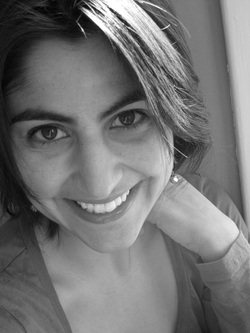 I'd like to build on my colleagues' excellent responses to this question by passing on three pieces of advice I've received over the years. I think about all three of these things almost every day. 1) Real, meaningful change is hard. Yes, we would all very much like to diversify our (fill in the blank... design teams, front of house staff, board, mainstage season...). We talk about it all the time. We reach out, we make good faith efforts to widen our net, but when it comes down to the wire, we too often find ourselves with something that looks more or less the same as the last thing we had. I think there's only one answer to this: try harder. We can't let ourselves off the hook. It will take more time, more energy, and more money than we think it will to get results. And at the end of the day, what matters is results; good intentions count for very little. 2) Follow The Money. If we only have four equity contracts in a show with seven actors, who gets the equity contracts? If we have the money to commission one play every three years, who gets the commission? If we can give extra hours to one front of house employee, who gets the hours? What about the businesses who cater our openings, do our dry cleaning, print our posters, do our audit, our accounting, our banking - who owns those business? (and where are they? are we supporting the local economies we rely on?) Arts organizations (and artists) do have and spend money. Thinking of the resources we have as abundant rather than scare allows us to take responsibility for the choices we make about what to do with those resources. 3) No Rage, No Pity. The best directing advice I every got was from playwright Lydia Diamond, while I was directing Harriet Jacobs, Lydia's beautiful adaptation of Jacobs' 1861 slave narrative. Like most works that tackle traumatic, violent aspects of our history, the play requires intense attention to tone. Too often we have all seen well-meaning and earnest approaches to this kind of material result in extremes of indulgent hysteria on the one hand or stoic heroism on the other -- neither of which honors the swirling complexity of the events and people whose stories we are attempting to tell, nor the multiplicity of the audiences who have come to hear these stories. Before the start of rehearsals, Lydia said to me, "The material must be approached with no rage and no pity." I wrote "NO RAGE, NO PITY" on the cover of my script and had the ensemble do the same. I learned that when our approach to storytelling comes from a place of anger (even righteous anger) or sentimentality (even well-meaning sentiment), it can cloud our view of the humanity and truth of our work, making us more fearful and less interesting, more strident and less dynamic. Engaging with material and characters simply and directly, with compassion but without pity, with precision but without rage, was a great touchstone for making acting, design, and even marketing choices (and if you're interested in exactly how this works in the rehearsal room I can talk for hours about it...). For me, this remains the best way to "avoid audience pandering or cliche" and make our work "productive" - in the sense of resisting and transforming, rather than reproducing, the old, tired images and discourses. It works for all material. But, you know... it's hard. See #1. Thanks for this important conversation, Jackie. Please include my email address so that folks can contact me directly if desired: [email protected]. 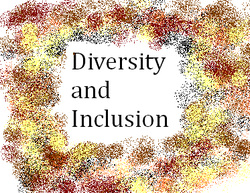 A few weeks ago, Megan Sanberg-Zakian (Boston area freelance director and one of TCG’s current New Generations Program Future Leaders) and I had an invigorating conversation about diversity. We met at the national conference during KJ Sanchez’s Set It Off: Peers Networking Workshop and connected immediately. Megan and I found ourselves in many of the same sessions and spent a good about of time processing our experiences. She reached out to me after reading the On Diversity and Inclusion Series with responses from some of TCG’s 2012 Young Leaders of Color. During our conversation, Megan shared how difficult it has been for her to hire designers of color. With each production, she makes a concerted effort to find women and people of color for stage management and design roles. Each time, she hits a wall. Celebrating and nurturing diversity is intrinsic to who she is as an artist and arts administrator. When she called me, she was beyond frustrated. We spoke for a little over an hour, but we wanted to do more than just talk. She suggested that we create a database of women and people of color who work in stage management and design. I sent her a list of folks in the D.C. area and counted my blessings once again to be living in a city filled a wide and varied number of wonderfully, talented theatre practitioners. I also reached out to Ed Sobel (Arden Theatre/PA), Seth Rozin (Interact Theatre/PA), Gregg Henry (Kennedy Center/D.C. and nationwide), Adrien-Alice Hansel (Studio Theatre and nationwide), and Megan Carter (The Women's Project/NY) for folks on their lists. If you’re reading this and you are (and/or know) a woman and person of color who works as a designer or stage manager, we’d love to know you. Please contact me with your information. Our conversation and this series has been made even more relevant ahead of TCG’s Fall Forum on Governance: Leading the Charge, which will be held in New York from November 9th to November 11th. The discussions, sessions, and speeches aim to provide working models to tackle questions like:
Seriously, folks, mark your calendars and register! I’m aching/hoping to be there. If all works out, I'll be reaching out to my New York cat-less friends for a sofa soon! In the meantime, I’d like to introduce you to five amazing, smart, talented and generous women who have contributed their thoughts to this round of the Diversity and Inclusion Series. I'll be sharing these responses with you in the coming days! _ 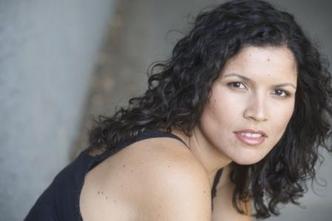 KHANISHA FOSTER Khanisha Foster is a mixed race actress, writer, teaching artist, the Associate Artistic Director of 2nd Story and an ensemble member of Teatro Vista. She was chosen for the Theatre Communication Groups’s Young Leaders of Color 2009 and an artist exchange with the Citizen’s Theatre of Scotland in Glasgow. She is a Sarah Siddon’s Society Scholarship recipient and a two time finalist for the PEN Emerging Voices Fellowship. Her teaching artist work has been honored by the White House. Her writing has been published with CellStories and podcast through 2nd Story, and will be published in the November release of the anthology Briefly Knocked Unconscious By a Low Flying Duck. She has performed with Teatro Vista, the Goodman Theatre, Steep Theater, and Collaboraction, among others. She can be seen in the film Chicago Boricua, official selection the Tribeca Film Festival, the Chicago Latino Film Festivals, and closing night selection for the New York Latino International Film Festival. Currently Khanisha is working on her memoir Heroin(e), several screenplays, and her second child who is due in less then three weeks! 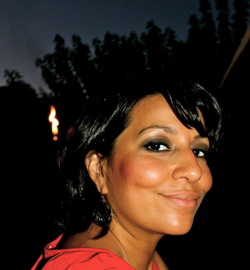 FANNY GARCIA Fanny García is the founder and editor of pLAywriting in the city, a blog about theater and the arts in Los Angeles. The blog aims to build a portfolio of art criticism written by people of color and increasing the coverage of work that is neglected by the mainstream media. She was a 2011 TCG Young Leader of Color and was featured in their I AM THEATRE campaign. Last year, she worked with Individual Artist Collective to send a delegation of artists of color to TCG’s 2012 conference in Boston. She has written several plays including Portrait of Ten Women, which chronicles the lives of Latina women living with HIV/AIDS. Her play The Rosalila received a workshop production directed by Luis Alfaro in 2010. She recently served as Associate Curator/Dramaturg for Watts Village Theater Company’s Meet Me @Metro. She is also actively involved in the creation of a national Latino theater alliance with Kinan Valdez of El Teatro Campesino and other theater collaborators. She is also one of the original co-founders of East LA Rep. 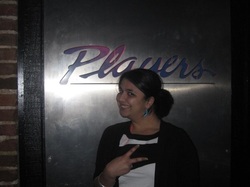 DEEKSHA GAUR Deeksha Gaur is the newly-appointed Director of Marketing and Public Relations at Woolly Mammoth Theatre Company. Prior to this, she served as Director of PR & Marketing at Two River Theater Company and Director of Marketing at Long Wharf Theatre. She is a proud member of the TCG New Generations Future Leaders program (round 7). Career highlights include producing new musical Ugo’s Last Dance by David Lefort Nugent in New York (for which she received the Foundry Theatre’s Producer’s Chair Award); producing A Bedtime Story at the Edinburgh Fringe, a play banned in India for seventeen years; running Summer Cabaret 2006 as the Associate Managing Director; and producing Mike Daisey's Invincible Summer at Yale Repertory Theatre. Brought up in Bombay and London, she got her undergraduate degree in history at Cambridge University, and her MFA in Theater Management from Yale School of Drama. 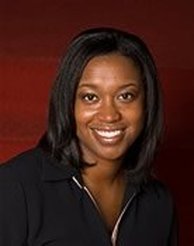 DAFINA MCMILLAN Dafina McMillan serves as the director of communications & conferences for Theatre Communications Group (TCG), the national service organization for not-for-profit theatre. In this role, Dafina oversees the overall internal and external communications strategy – as well as programs TCG’s convenings, including the TCG National Conference, which gathers more than 1,000 theatre practitioners annually. Prior to joining TCG, Dafina served as the associate managing director of Penumbra Theatre Company in St. Paul, MN, where she managed the day-to-day operations for the theatre, which included communications, fundraising, overseeing the annual fundraising gala and working directly with the board of directors. While previously in New York, she was an account supervisor at global public relations agency GCI Group (now Cohn & Wolfe) and implemented communication strategies for Fortune 500 companies. Dafina has served as a speech writer, led executive visibility and corporate social responsibility campaigns, supported brand launches, and worked with national media to secure online, print and broadcast coverage for her clients. She also consulted with the Brooklyn Center for the Performing Arts on marketing and community engagement initiatives. Dafina is an alumna of The John F. Kennedy Center’s International Arts Management Fellowship in Washington, D.C. Originally from Houston, TX, she received her bachelor of science degree in public relations from the University of Texas at Austin. 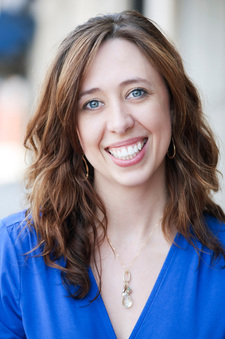 ERICA NAGEL Erica currently serves as the Artistic Engagement Manager at McCarter Theatre Center where her work bridges literary, producing, marketing, and educational projects under the umbrella of community and audience engagement. She also teaches courses in Community-based Performance and Devising Theatre with Youth at Princeton University. Originally from Western Massachusetts, Erica has worked on the artistic staffs of Geva Theatre, Williamstown Theatre Festival, and Premiere Stages, and as a freelance dramaturg throughout the country. She is a proud recipient of a 2005 LMDA Dramaturg-Driven grant to create Bare Mountains, a documentary theatre piece exploring the creation of the Palisades Interstate Park System using interviews with communities who were displaced by eminent domain in the 1920s and 30s. In 2010, she was chosen to participate in the TCG New Generations Future Leaders program, which “seeks to identify exceptionally talented theatre professionals who will impact the field in a positive way.” Erica has conceived and overseen community-based arts programs with community partners including The Human Rights Institute, The Darfur Rehabilitation Project, New York State Parks, and the Orange County Department of Veterans Affairs. Erica received her B.A. from Washington University in St. Louis, and her M.F.A. in Performance as Public Practice (Theatre and Social Change) from the University of Texas-Austin, where she regularly wore cowgirl boots to rehearsal. 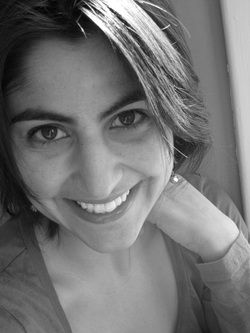 MEGAN SANDBERG-ZAKIAN Megan Sandberg-Zakian is a current recipient of the Theater Communication Group (TCG) “Future Leaders” grant to spend two seasons at Central Square Theater in Cambridge, MA, working on a series of publically-engaged development and production projects. This January she will direct The Mountaintop for Underground Railway Theater (URT). Other recent directing projects include: The Brother Sister Plays at Company One (IRNE Award: Best Production; IRNE nominee: Best Director; Elliot Norton Nominee: Best Production), Lydia Diamond’s Harriet Jacobs at URT (Elliot Norton Nominee: Best New Play; IRNE Nominee: Best Ensemble, Best Actress) and the RI premiere of Hedwig and the Angry Inch at Perishable Theatre/Trinity Repertory Company (Motif Awards: Best Production, Best Set Design, Best Actor). Megan has served as Associate Artistic Director of the Providence Black Repertory Company (RI) and The 52nd Street Project (NYC). She is a graduate of Brown University and holds an MFA in Interdisciplinary Arts from Goddard College. www.megansz.com Jacqueline Lawton: How long have you lived and worked as a playwright in DC? What brought you here? Why have you stayed?
Marni Penning Coleman: I grew up in Arlington, and used to write little plays to put on in our living room or backyard. My sisters and I, and our friends, would invite the entire neighborhood, and make tickets; it was quite the production. I have always enjoyed writing, but didn't really start writing plays until 2003, and finished my first full-length in 2006. I've worked a lot in DC as an actor, butfrom 1994 to 2000 I lived in Cincinnati, and from 2000 to 2009 I was based in New York. So I've just relocated full-time back to DC in 2009 to marry my wonderful husband. JL: Have you ever been a member of a DC area playwrights writing group? If so, did you find it useful? Would you recommend that other playwrights join them? MPC: I haven't; the only playwrights' group I've ever been a part of is the LA Writers Center; I've been a member since 2006. I would love to get involved with a group of playwrights here in DC - perhaps I'd actually finish the two other plays I'm working on right now! :) JL: In DC, we have the Capital Fringe Festival, the Intersections Festival, the Source Theatre Festival, the Kennedy Center's Page-to-Stage Festival, the Black Theater Festival, and the Hip Hop Theatre Festival. We also have the Mead Lab at Flashpoint Theater Lab Program. Have you participated in any of these? If so, can you speak about your experience? MPC: I've only been involved with the Fringe Festival as an actor last summer; I thought about producing Carol's Christmas at the Fringe, but Pinky Swear Productions snapped it up before I had a chance to do that, so I was very lucky. I'm hoping to get more involved with those festivals as I produce more work. JL: What kind of work do you do to pay the bills? How do you balance this work with your writing? MPC: I started writing when I was on the road as an actor, so my "day job" was acting. I was lucky enough to make my living solely as an actor. When I was in "The Unmentionables" at Woolly Mammoth, I really came to admire Bruce Norris. He and I talked a lot about being an actor who writes plays, and how that helps our playwright's voice. He was huge inspiration to me. Since I've moved back to DC, I do voiceovers, I've taught, I coach, and also have been working as the Sales Trainer at the Container Store in Clarendon. Full-time work has really hampered my writing, though. I kept copious notes in my iPhone for play ideas, but wasn't making the time to write them out. I'm hoping to do more now that I'm home with my one month old son (and have a good dictation program, since my hands are never free to type!) JL: How many plays have you had produced in the DC area? Were any of these plays self-produced? If so, where and what did you learn from that experience? MPC: My first full-length play, Carol's Christmas, was produced by Pinky Swear Productions last November and December. I have not self produced down here in DC. I loved working with the women of Pinky Swear. It was a fantastic experience as a playwright, and what I learned was to trust the actors and director and step back from the rehearsal process. I was too close to the words; I knew if I was there at every rehearsal, or even half the rehearsals, they wouldn't be able to find things I didn't realize were there. I had already had two readings of the show and DC and in LA, and I just needed a committed group to take the show and run with it - which they did, and I'm very proud of the results. JL:If you could be produced at any theatre in DC, which would it be and why? MPC: I'm a huge fan of Woolly Mammoth. I've done three shows there, and I love the type of quirky, edgy, pushing-the-envelope material that they produce. If I could aspire to write a show that would be accepted anywhere, I would pick Woolly. JL: DC audiences are ... MPC: Loyal. JL: DC actors, designers and directors are ... MPC: Some of the best I've worked with in the country. JL: DC critics are ... MPC: Ah, how do I answer this one? Every artist has a love-hate relationship with critics. But most critics in DC seem to have a genuine love of the theater, and love getting the word out about work that they admire. It's like anywhere else, I guess. You need to have publicity to get the word out about your shows, but if the reviews have a negative bent (and some critics tend to lean that way more than others), everyone wishes the critics wouldn't be quite so "critical." Know what I mean? That said, we do have some very good advocates for the arts in our community. My take is, you can say anything you want, just spell our names right and put them in big letters with a great big photo. :) JL: How do you feel the DC theatre community has addressed the issues of race and gender parity? How has this particular issue impacted you and your ability to get your work produced on the main stages? MPC: In DC we have such a diverse community, it feels like we're always celebrating our differences in a good way, whether it be nationality or race or gender. This isn't a town that only churns out plays by dead white males. I haven't been produced on the main stages, so I can't speak to that part of the question. But I don't feel that me being a woman would hinder my chances at all; it always seems that our arts centers are actively seeking out diversity. JL: What advice do you have for an up and coming DC based playwright or a playwright who has just moved to D.C.? MPC: Go see plays at every theater you can. Introduce yourself to everyone and let them know you're new in town, or that you're a playwright if they don't know you yet. The arts world is so small, you're bound to have people in common. Get to know each arts organization and their strengths, and get in touch with artists whose work you admire. It's always flattering for actors to hear from playwrights who say they like their work. Build your network this way, then when you've got a piece that's ready, you already have a built-in base of people with whom you can share it. If it's not right for one person, they may know someone else for whom it might be a fit. Be open to anything! JL: What's next for you as a playwright? Where can we keep up with your work? MPC: I was on hiatus from the theater while I was pregnant, and I'm slowly getting my feet back under me, but it's still early. I'm two thirds of the way through my next full-length, and I have another full-length play rattling around in my brain that I just need to get down on paper. You can follow what's happening with my work on my website - www.MarniPenning.com. Maybe now that I'm a mom, my writing will take a different bent. We'll have to see! |
My BlogI'm a playwright, dramaturg, and teaching artist. It is here where you'll find my queries and musings on life, theater and the world. My posts advocate for diversity, inclusion, and equity in the American Theatre and updates on my own work. Please enjoy!
Categories
All
Archives
June 2020
Reading List
|
